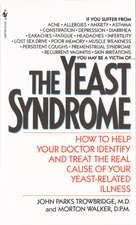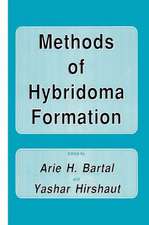Breast Cancer: The Complete Guide
Autor Yashar Hirshaut, Peter I. Pressman Jane Brodyen Limba Engleză Paperback – 31 aug 2008
Breast cancer will strike one out of every eight women in the United States. Because there have been many important changes in the diagnosis and treatment of breast cancer in the last few years, this fully revised Third Edition contains information on the latest developments in the field, including:
• new diagnostic procedures
• changes in the treatment of in situ cancer
• improved surgical techniques
• gene testing
• sequencing radiation and chemotherapy
• HER-2Neu (Herceptin)
• tamoxifen for prevention
• bone marrow and stem cell transplants
• and more
Preț: 138.14 lei
Nou
Puncte Express: 207
Preț estimativ în valută:
26.43€ • 27.60$ • 21.83£
26.43€ • 27.60$ • 21.83£
Carte disponibilă
Livrare economică 25 martie-08 aprilie
Preluare comenzi: 021 569.72.76
Specificații
ISBN-13: 9780553385915
ISBN-10: 0553385917
Pagini: 420
Dimensiuni: 152 x 226 x 30 mm
Greutate: 0.59 kg
Ediția:Revised
Editura: Bantam
ISBN-10: 0553385917
Pagini: 420
Dimensiuni: 152 x 226 x 30 mm
Greutate: 0.59 kg
Ediția:Revised
Editura: Bantam
Notă biografică
Yashar Hirshaut is a medical oncologist specializing in the treatment of breast cancer. A graduate of the Albert Einstein College of Medicine, he completed his oncology training at the National Cancer Institute in Bethesda, Maryland, and at the Memorial Sloan-Kettering Cancer Center in New York. Form 1970 to 1986 he served as an attending physician at Memorial Sloan-Kettering on the Clinical Immunology Service and an associate professor of medicine at the Cornell University Medical College. He was also head of the Laboratory for Immuno-diagnosis at Sloan-Kettering. In addition to being in private practice, he is currently associate clinical professor of medicine at Cornell University, adjunct professor of biology at Yeshiva University, and an attending physician at Mount Sinai Medical Center and Beth Israel and Lenox Hill Hospitals in New York City.
Peter I Pressman is a surgical oncologist who specializes in the treatment of breast cancer. A graduate of Columbia College and the Columbia University College of Physicians and Surgeons, he trained at Presbyterian Hospital and the Columbia Division of Bellevue Hospital in New York City. Dr. Pressman has been in private practice in New York for over thirty-five years and is Clinical Professor of Surgery at the Weill Medical College of Cornell University. He was attending surgeon at Beth Israel Medical Center and Lenox Hill Hospital.
Peter I Pressman is a surgical oncologist who specializes in the treatment of breast cancer. A graduate of Columbia College and the Columbia University College of Physicians and Surgeons, he trained at Presbyterian Hospital and the Columbia Division of Bellevue Hospital in New York City. Dr. Pressman has been in private practice in New York for over thirty-five years and is Clinical Professor of Surgery at the Weill Medical College of Cornell University. He was attending surgeon at Beth Israel Medical Center and Lenox Hill Hospital.
Extras
How do I know which type of surgery is right for me?
Our basic job is to get rid of the cancer and prevent its spread and recurrence, if possible while preserving the breast. In order to accomplish that task, we have to understand the nature or pathology of the malignancy; its stage, including its size and how much it has spread; its location in the breast; and the size of the breast itself. We also have to give serious consideration to what you yourself prefer.
The following sections describe the general circumstances under which each type of surgery is appropriate.
Stage 0 Cancer
Stage 0 cancers are noninfiltrating cancers confined to the lobules and ducts.
Lobular carcinoma in situ (LCIS), generally speaking, requires no surgery after the biopsy. It should, however, be very carefully watched. Mammography and a physical examination by a doctor should be regularly scheduled because this in situ cancer is what we call a marker of great risk. Twenty percent of women with this symptom develop infiltrating cancers over a twenty-year period and there is a likelihood that both breasts are at risk.
In the past, duct cell carcinoma in situ (DCIS) was usually discovered after a biopsy for a nipple discharge or ulceration. With the recent improvements in mammography, we are able to pick up very early abnormalities, and now over twenty percent of the women we treat for breast cancer have DCIS.
To treat DCIS, we do a total mastectomy (without lymph node removal) or we do a lumpectomy followed by radiation therapy. Which procedure to choose poses a dilemma. We know that if we treat DCIS with mastectomy, we can achieve close to one hundred percent success. If we preserve the breast with a wide excision and radiotherapy, there is a one-percent-a-year recurrence rate. Of those women who have a recurrence, half can be successfully treated with mastectomy. The other half will have infiltrating disease. Some of them will be cured, but some lives will be lost.
Many women and their doctors say, “If there is any risk of recurrence at all, do a mastectomy.” Others decide that one percent a year is an acceptable risk. They are opting for as wide an excision as can be done to avoid deformity, along with radiation therapy.
As we will see below, invasive cancers are treated with lumpectomy, node removal, and radiation. It seems paradoxical that cases of DCIS — that is, of noninvasive cancer — are often treated with mastectomy because of the one hundred percent cure rate. As one of my patients said, “Is the loss of my breast the reward I get for finding cancer before it has spread?”
There are studies now under way to try to resolve this dichotomy, and to find out whether, in some cases of DCIS, wide excision alone is adequate treatment. In the meantime, if you have an in situ ductal cancer, you and your doctor will have to carefully discuss and weigh your treatment options We are not yet at the point where, as in early lobular cancers, we can monitor and observe and, at least, delay surgery. But treatment for intraductal carcinomas in situ can and should be individualized and the options carefully weighed as to their physical and emotional consequences.
Stage I and Stage II Cancers
The discussion of treatment for these cancers is best begun with a quote from “the horse’s mouth,” a conference convened by the National Institutes of Health (NIH) to evaluate available scientific information and to “resolve safety and efficacy issues related to biomedical technology.” According to the findings of this NIH Consensus Conference on early, invasive breast cancer, in June 1990, “Breast conservation treatment is an appropriate method of primary therapy for the majority of women with Stages I and II breast cancer and is preferable because it provides survival rates equivalent to those of total mastectomy [modified radical] and axillary dissection while preserving the breast.”
To clarify, lumpectomy with axillary dissection and radiation therapy is the preferable treatment for small infiltrating cancers of either the lobules or the ducts.
There are, however, circumstances where mastectomy is the treatment advised for Stage I and Stage II cancers:
• More than one cancerous tumor in the breast
• Multiple areas of microcalcification (see page 77) in the breast
• A relatively large tumor in a small breast or a tumor in or near the center of the breast
• Considerable axillary lymph-node involvement
In addition, some physicians consider mastectomy the preferred treatment in the following circumstances:
• Extensive intraductal cancer in situ within and adjacent to the primary tumor
• An infiltrating cancer plus a considerable amount of intraductal cancer
Under certain circumstances, we may recommend a bilateral mastectomy when there is lobular cancer in situ:
• If there have been recurrent lumps that required biopsy
• If mammograms show calcifications that are difficult to interpret
• If there is an extremely strong family history of breast cancer
Stage III Cancers
We have, up until now, been discussing early, relatively small cancers. As we saw in Chapter Three, some women come for treatment with more advanced disease. In such cases, the cancer may be in the skin of the breast, it may be of the inflammatory type, it may be accompanied by extensive lymph-node involvement, or the tumor may be over five centimeters (about two inches) in size.
For Stage III cancers, chemotherapy (see Chapter Ten) is the first treatment. It is used to treat inflammatory cancer and also to shrink a large tumor to operable size. Surgery, usually a modified radical mastectomy, is performed after the tumor has shrunk.
Stage IV Cancers
Stage IV cancers have spread beyond the breast and the axillary lymph nodes to other places in the body. They are treated primarily with chemotherapy. Surgery — lumpectomy or modified radical mastectomy — or radiation therapy may sometimes be used to assist in local tumor control.
It is important to say here that I have patients in my practice who came to me with a large tumor and who have done well, usually with chemotherapy followed by surgery. In a few instances, where the tumor was inoperable, some women have survived for many years on long-term chemotherapy.
Cancer in Pregnancy
As we saw in Chapter Three, breast cancer in pregnant women tends to be discovered at a later stage than cancer in other women. Our general approach is to “abort the cancer, not the baby.” However, when cancer is discovered during the first trimester, women usually choose to terminate the pregnancy and then to promptly seek the most appropriate treatment for the disease.
During the second trimester or later, a mastectomy can be safely performed. We do not use radiation with pregnant women so as not to risk the well-being of the fetus. Chemotherapy may be started only in the very last weeks of pregnancy.
Treatment Options
To summarize the sequence of treatment that may be recommended for all stages of breast cancer:
STAGE 0
LOBULAR CARCINOMA IN SITU
1. Biopsy
2. Observation
3. Possible hormone therapy
or
1. Bilateral mastectomy
2. Breast reconstruction
DUCTAL CARCINOMA IN SITU
1. Biopsy
2. Mastectomy
or
1. Wide excision with observation only (experimental)
or
1. Wide excision plus radiation
STAGE I
1. Biopsy
2. Partial (lumpectomy) or modified radical mastectomy
3. Axillary dissection
4. If mastectomy, possible breast reconstruction
5. If lumpectomy, radiation therapy
6. Possible hormone therapy or chemotherapy
STAGE II
1. Biopsy
2. Lumpectomy or modified radical mastectomy
3. Axillary dissection
4. If mastectomy, possible breast reconstruction
5. If lumpectomy, radiation therapy
6. Hormone therapy or chemotherapy
STAGE III
1. Biopsy
2. Course of chemotherapy
3. Modified radical mastectomy
4. Continued chemotherapy
5. Radiation therapy
STAGE IV
1. Biopsy
2. Course of chemotherapy
3. If appropriate, lumpectomy
or
Modified radical mastectomy
4. Continued chemotherapy
Our basic job is to get rid of the cancer and prevent its spread and recurrence, if possible while preserving the breast. In order to accomplish that task, we have to understand the nature or pathology of the malignancy; its stage, including its size and how much it has spread; its location in the breast; and the size of the breast itself. We also have to give serious consideration to what you yourself prefer.
The following sections describe the general circumstances under which each type of surgery is appropriate.
Stage 0 Cancer
Stage 0 cancers are noninfiltrating cancers confined to the lobules and ducts.
Lobular carcinoma in situ (LCIS), generally speaking, requires no surgery after the biopsy. It should, however, be very carefully watched. Mammography and a physical examination by a doctor should be regularly scheduled because this in situ cancer is what we call a marker of great risk. Twenty percent of women with this symptom develop infiltrating cancers over a twenty-year period and there is a likelihood that both breasts are at risk.
In the past, duct cell carcinoma in situ (DCIS) was usually discovered after a biopsy for a nipple discharge or ulceration. With the recent improvements in mammography, we are able to pick up very early abnormalities, and now over twenty percent of the women we treat for breast cancer have DCIS.
To treat DCIS, we do a total mastectomy (without lymph node removal) or we do a lumpectomy followed by radiation therapy. Which procedure to choose poses a dilemma. We know that if we treat DCIS with mastectomy, we can achieve close to one hundred percent success. If we preserve the breast with a wide excision and radiotherapy, there is a one-percent-a-year recurrence rate. Of those women who have a recurrence, half can be successfully treated with mastectomy. The other half will have infiltrating disease. Some of them will be cured, but some lives will be lost.
Many women and their doctors say, “If there is any risk of recurrence at all, do a mastectomy.” Others decide that one percent a year is an acceptable risk. They are opting for as wide an excision as can be done to avoid deformity, along with radiation therapy.
As we will see below, invasive cancers are treated with lumpectomy, node removal, and radiation. It seems paradoxical that cases of DCIS — that is, of noninvasive cancer — are often treated with mastectomy because of the one hundred percent cure rate. As one of my patients said, “Is the loss of my breast the reward I get for finding cancer before it has spread?”
There are studies now under way to try to resolve this dichotomy, and to find out whether, in some cases of DCIS, wide excision alone is adequate treatment. In the meantime, if you have an in situ ductal cancer, you and your doctor will have to carefully discuss and weigh your treatment options We are not yet at the point where, as in early lobular cancers, we can monitor and observe and, at least, delay surgery. But treatment for intraductal carcinomas in situ can and should be individualized and the options carefully weighed as to their physical and emotional consequences.
Stage I and Stage II Cancers
The discussion of treatment for these cancers is best begun with a quote from “the horse’s mouth,” a conference convened by the National Institutes of Health (NIH) to evaluate available scientific information and to “resolve safety and efficacy issues related to biomedical technology.” According to the findings of this NIH Consensus Conference on early, invasive breast cancer, in June 1990, “Breast conservation treatment is an appropriate method of primary therapy for the majority of women with Stages I and II breast cancer and is preferable because it provides survival rates equivalent to those of total mastectomy [modified radical] and axillary dissection while preserving the breast.”
To clarify, lumpectomy with axillary dissection and radiation therapy is the preferable treatment for small infiltrating cancers of either the lobules or the ducts.
There are, however, circumstances where mastectomy is the treatment advised for Stage I and Stage II cancers:
• More than one cancerous tumor in the breast
• Multiple areas of microcalcification (see page 77) in the breast
• A relatively large tumor in a small breast or a tumor in or near the center of the breast
• Considerable axillary lymph-node involvement
In addition, some physicians consider mastectomy the preferred treatment in the following circumstances:
• Extensive intraductal cancer in situ within and adjacent to the primary tumor
• An infiltrating cancer plus a considerable amount of intraductal cancer
Under certain circumstances, we may recommend a bilateral mastectomy when there is lobular cancer in situ:
• If there have been recurrent lumps that required biopsy
• If mammograms show calcifications that are difficult to interpret
• If there is an extremely strong family history of breast cancer
Stage III Cancers
We have, up until now, been discussing early, relatively small cancers. As we saw in Chapter Three, some women come for treatment with more advanced disease. In such cases, the cancer may be in the skin of the breast, it may be of the inflammatory type, it may be accompanied by extensive lymph-node involvement, or the tumor may be over five centimeters (about two inches) in size.
For Stage III cancers, chemotherapy (see Chapter Ten) is the first treatment. It is used to treat inflammatory cancer and also to shrink a large tumor to operable size. Surgery, usually a modified radical mastectomy, is performed after the tumor has shrunk.
Stage IV Cancers
Stage IV cancers have spread beyond the breast and the axillary lymph nodes to other places in the body. They are treated primarily with chemotherapy. Surgery — lumpectomy or modified radical mastectomy — or radiation therapy may sometimes be used to assist in local tumor control.
It is important to say here that I have patients in my practice who came to me with a large tumor and who have done well, usually with chemotherapy followed by surgery. In a few instances, where the tumor was inoperable, some women have survived for many years on long-term chemotherapy.
Cancer in Pregnancy
As we saw in Chapter Three, breast cancer in pregnant women tends to be discovered at a later stage than cancer in other women. Our general approach is to “abort the cancer, not the baby.” However, when cancer is discovered during the first trimester, women usually choose to terminate the pregnancy and then to promptly seek the most appropriate treatment for the disease.
During the second trimester or later, a mastectomy can be safely performed. We do not use radiation with pregnant women so as not to risk the well-being of the fetus. Chemotherapy may be started only in the very last weeks of pregnancy.
Treatment Options
To summarize the sequence of treatment that may be recommended for all stages of breast cancer:
STAGE 0
LOBULAR CARCINOMA IN SITU
1. Biopsy
2. Observation
3. Possible hormone therapy
or
1. Bilateral mastectomy
2. Breast reconstruction
DUCTAL CARCINOMA IN SITU
1. Biopsy
2. Mastectomy
or
1. Wide excision with observation only (experimental)
or
1. Wide excision plus radiation
STAGE I
1. Biopsy
2. Partial (lumpectomy) or modified radical mastectomy
3. Axillary dissection
4. If mastectomy, possible breast reconstruction
5. If lumpectomy, radiation therapy
6. Possible hormone therapy or chemotherapy
STAGE II
1. Biopsy
2. Lumpectomy or modified radical mastectomy
3. Axillary dissection
4. If mastectomy, possible breast reconstruction
5. If lumpectomy, radiation therapy
6. Hormone therapy or chemotherapy
STAGE III
1. Biopsy
2. Course of chemotherapy
3. Modified radical mastectomy
4. Continued chemotherapy
5. Radiation therapy
STAGE IV
1. Biopsy
2. Course of chemotherapy
3. If appropriate, lumpectomy
or
Modified radical mastectomy
4. Continued chemotherapy
Recenzii
“It should be required reading for everyone who is touched by the disease, whether personally or through a family member, friend, colleague, employee, or a patient diagnosed with breast cancer.... I can’t recommend it enough.”— Today’s OR Nurse
“These experts demystify breast cancer in understandable and compassionate terms.... Should help hundreds of thousands of women.”— James F. Holland, M.D. Chairman, Department of Neoplastic Diseases, Mount Sinai Medical Center
“Both timely and current — [It] discusses the most common cancer in women in a precise, clear, and positive way, providing essential information in a warm, supportive fashion in a readable and understandable format.”— Journal of the National Cancer Institute
“Comprehensive, up-to-date, and highly detailed ... From selecting the best doctors to describing procedures and treatments, the authors answer all possible questions in a calm, rational manner.... Highly recommended.”— Library Journal
“Every woman is touched by the reality of breast cancer — by the fear of it or the fact of it.... Drs. Pressman and Hirshaut have written the essential guide, one that should be required reading for every woman.”— Barbara Gordon author of I’m Dancing as Fast as I Can
“This is a humane, compassionate book which nonetheless manages to be straightforward and comprehensive; the authors have succeeded in addressing the many questions (and the fears) of breast cancer patients, and have done a thorough and sensitive job.”— Share
“These experts demystify breast cancer in understandable and compassionate terms.... Should help hundreds of thousands of women.”— James F. Holland, M.D. Chairman, Department of Neoplastic Diseases, Mount Sinai Medical Center
“Both timely and current — [It] discusses the most common cancer in women in a precise, clear, and positive way, providing essential information in a warm, supportive fashion in a readable and understandable format.”— Journal of the National Cancer Institute
“Comprehensive, up-to-date, and highly detailed ... From selecting the best doctors to describing procedures and treatments, the authors answer all possible questions in a calm, rational manner.... Highly recommended.”— Library Journal
“Every woman is touched by the reality of breast cancer — by the fear of it or the fact of it.... Drs. Pressman and Hirshaut have written the essential guide, one that should be required reading for every woman.”— Barbara Gordon author of I’m Dancing as Fast as I Can
“This is a humane, compassionate book which nonetheless manages to be straightforward and comprehensive; the authors have succeeded in addressing the many questions (and the fears) of breast cancer patients, and have done a thorough and sensitive job.”— Share
Descriere
Written by two renowned authorities who specialize in the treatment of breast cancer, a surgeon and an oncologist, this lucid step-by-step guide has established itself as the indispensable book women need to make informed decisions about the care that is right for them.













